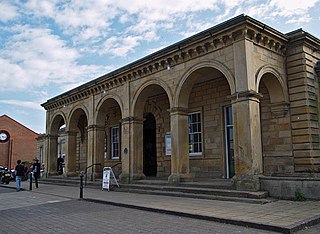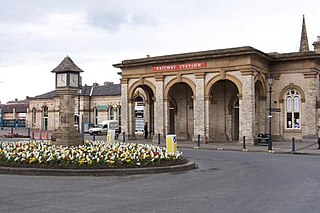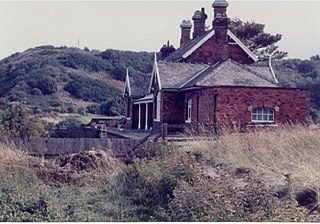
Cleveland or Lower Teesdale is low-lying land north of the North York Moors and around the River Tees, of England. The vale is a continuation of the Vale of Mowbray to the south west. The name Cleveland comes from a variant of "cliff-land", referring to the view to and from the Hills of Cleveland. These hills rises to nearly 1,500 ft (460 m) and are a part of the North York Moors.

Saltburn-by-the-Sea is a seaside town in Redcar and Cleveland, North Yorkshire, England, around 26 miles (42 km) south east of Hartlepool. It lies within the historic boundaries of the North Riding of Yorkshire. It has a population of around 6,000.
The Esk Valley Line is a railway line located in the north of England, covering a total distance of around 30 miles (48 km), running from Middlesbrough to Whitby. The line follows the course of the River Esk for much of its eastern half.

Middlesbrough South and East Cleveland is a constituency created in 1997 represented in the House of Commons of the UK Parliament since 2017 by Simon Clarke of the Conservative Party. The local electorate returned a Labour MP in the seat's first five general elections; in the following election Clarke became its first Conservative MP.

Commondale railway station serves the village of Commondale in North Yorkshire, England. It is located on the Esk Valley Line and is operated by Northern Trains who provide all of the station's passenger services.

Ruswarp railway station serves the village of Ruswarp in North Yorkshire, England. It is located on the Esk Valley Line and is operated by Northern Trains who provide all of the station's passenger services. The station is 33.5 miles (53.9 km) from Middlesbrough and 1.5 miles (2.4 km) from Whitby. It opened in 1848.

Whitby railway station is a Grade II listed station which serves the town of Whitby in North Yorkshire, England. It is the terminus of the Esk Valley Line from Middlesbrough. The station is situated 35 miles (56 km) south-east of Middlesbrough and is operated by Northern Trains, which provides all of the station's National Rail passenger services. The station is also served during the summer months by the heritage North Yorkshire Moors Railway, whose line connects with the Esk Valley line at Grosmont.

Saltburn railway station serves the town of Saltburn-by-the-Sea in the borough of Redcar and Cleveland and the ceremonial county of North Yorkshire, England. It is the terminus of the Tees Valley Line and is operated by Northern Trains who provide all passenger train services.

Pickering railway station is the southern terminus of the North Yorkshire Moors Railway and serves the town of Pickering in North Yorkshire, England.

Lockwood is a civil parish in the unitary authority of Redcar and Cleveland with ceremonial association with North Yorkshire, England. The population of Lockwood ward in the Redcar and Cleveland Unitary authority taken at the 2011 census was 2,022.
The Whitby, Redcar and Middlesbrough Union Railway (WRMU) was a railway line in North Yorkshire, England, built between 1871 and 1883, running from Loftus on the Yorkshire coast to the Esk at Whitby, and connecting Middlesbrough to Whitby via previously built lines in Cleveland.
The Middlesbrough & Guisborough Railway (M&G) was a railway line serving the towns of Middlesbrough and Guisborough as well as areas of the Eston Hills in North Yorkshire from 1853 through to 1964.
The Forge Valley Line was a 16 mile long branch of the North Eastern Railway between Seamer and Pickering. The line was intended to link Scarborough with Pickering. It opened in 1882 and closed in 1950, with the exception of a stretch from Pickering to Thornton Dale which remained open for quarry traffic until 1963.

Ravenscar was a railway station on the Scarborough & Whitby Railway and served the village of Ravenscar, North Yorkshire, England.

Whitby West Cliff railway station was a railway station on the Whitby Redcar and Middlesbrough Union Railway. It was opened on 3 December 1883, to serve the West Cliff area of the town of Whitby, North Yorkshire, England. It was one of two stations serving Whitby; the other was Whitby Town railway station, which served the lines to Malton and Battersby.

Sandsend railway station was a railway station on the Whitby, Redcar and Middlesbrough Union Railway. It was opened on 3 December 1883, and served the villages of Sandsend and Lythe. It closed on 5 May 1958. The station building is now a private residence. It was the only station between Whitby and Loftus not to possess a passing loop.

Guisborough railway station was the terminus of the Middlesbrough and Guisborough Railway. It served the town of Guisborough in North Yorkshire, England. The station was opened on 25 February 1854 and closed, along with the entire Nunthorpe-Guisborough branch, on 2 March 1964.
The Cleveland Railway was a railway line in north-east England running from Normanby Jetty on the River Tees, near Middlesbrough, via Normanby and then via Guisborough through the Eston Hills, to Loftus in East Cleveland. It carried minerals from numerous iron ore mines along its route to the River Tees for shipment to Tyneside and elsewhere. The line was jointly proposed by the West Hartlepool Harbour and Railway (WHH&R), who provided half its capital, together with various landowners. The WHH&R lay on the north bank of the Tees, to which it had a cross-river connection via a jetty at Normanby.

Skinningrove railway station was on the Whitby, Redcar and Middlesbrough Union Railway. It was opened on 1 April 1875, and served the villages of Skinningrove and Carlin How in North Yorkshire, England. It was originally named "Carlin How", but was renamed on 1 October 1903 by the North Eastern Railway. It had no goods service, but a zig zag track branched off just outside the station from a point on the main line towards Saltburn, serving the Loftus Mines in the valley below, where ironstone was mined. This closed in 1958. Further north towards Brotton, near the village of Carlin How, the tracks serving Skinningrove Steelworks branch off the line.

Potto railway station was a railway station built just north of the village of Potto in North Yorkshire, England. The station was on the North Yorkshire and Cleveland's railway line between Picton and Stokesley. The line was extended progressively until it met the Whitby and Pickering Line at Grosmont. Potto station was closed in 1954 to passengers and four years later to goods.















